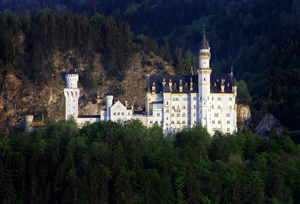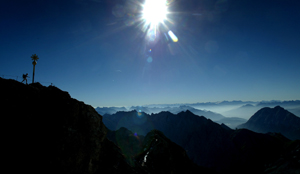The Ecuadoreans have colds. The Angolans are shivering. Trinidad and Tobago
players stuffed their hands deep in their pockets as they took the field for a
friendly.
In Hamburg, about 320 kilometers (200 miles) to the north, even the locals
are bundling up in thick wool coats and scarves.

A south Bavarian
castle, Neuschwanstein, is seen near Schwangau, about 120 km (75 miles)
south of Munich. Neuschwanstein Castle, one of the most popular
destinations in Europe was built by King Ludwig II in 1869.
[Reuters] |
Cool temperatures are putting the b-r-r-r in Berlin and the rest of Germany,
with days to go until the World Cup starts.
"It's supposed to be hot here this time of year," Angola defender Luis
Delgado said. "Since we've been here, some days have been warm, but most have
been cold. ... I don't like it."
Germany's average temperature in June ranges from the upper 60s F (about 20
C) in the north to the mid-70s F (mid-20s C) in the south. Hardly tropical, but
downright balmy compared with the cold, rain and gloom which has settled over
the country for the past two weeks. There was even some snow at the English and
Dutch training camps, though it fell before the teams arrived.
On Monday, high temperatures throughout Germany hovered in the low 50s F (low
10s C), while the low in Leipzig was 37 F (3 C). There was finally some
intermittent sunshine, but not enough to warm the chill in the air.
"It is certainly cooler than normal," said Dorothea Paetzold, a meteorologist
with the German Weather Service. "But it was expected because it was the same
the week before."
That's little consolation for teams from warm-weather regions. Or those who
mistakenly assumed the World Cup was a summer event.
"For some of the guys who play in Trinidad, it's tough for them because now
it is summer. It should be summer in Europe," said Trinidad forward Stern John,
who plays for Coventry in England's second division. "But that's how it is
here."
Try being the four newcomers from Africa. Angola, Ghana, Ivory Coast and Togo
are all making their first World Cup appearance, a daunting enough prospect
without having to train in weather which is the polar opposite of what they're
used to.

A tourist walks to the
top of Germany's highest mountain, the 2,962 metre (9,718 feet) Zugspitze
in front of the mountain panorama of the Austrian Alps near the southern
Bavarian resort of
Garmisch-Partenkirchen.[Reuters] |
Togo and the Ivorians have several players based in Europe, where the season
just ended, and that makes their adjustment to the weather a little easier.
Ivory Coast's Didier Drogba, for example, plays for Chelsea, and everyone knows
London isn't exactly the place for fine weather. Karim Guede of Togo plays in
Germany at Hamburger SV, so this cold snap is nothing new to him.
But most of Angola and Ghana's players are based in domestic leagues. Both
countries are in western Africa, near the equator. It was 90 degrees F (32
degrees C) in Ghana on Monday, with the humidity making it feel more like 100
(38). In Angola, it was 82 F (28 C) and humid.
"I'm used to playing in a tropical climate," Delgado said.
For some, though, the arctic air hasn't been a problem.
Portugal trained at home, where it's already nice and toasty in the upper 80s
F (low 30s C), and its World Cup base is in northwestern Germany. But trainer
Darlan Schneider said the players have adjusted just fine. The Portuguese were
more worried about humidity than cold, team doctor Henrique Jones said.
"It's much easier to adapt from hot to cold than vice versa," Schneider said.
Costa Rica got a little help from its embassy _ and the air conditioner in
its bus. Embassy staff warned that it was going to be colder than expected, so
the team came prepared. When players travel in Germany, they turn the air
conditioner to the coldest setting so it doesn't seem so bad when they get
outside.
The Americans have one of the northernmost bases in Hamburg. But half of the
roster plays in Europe, including three players who are on German teams.
"It would be nice if it was a little warmer," said U.S. goalkeeper Kasey
Keller, who plays professionally for Germany's Borussia Moenchengladbach. "But
we can't do anything about that."
Besides, it could be worse. When the World Cup was in Argentina in 1978, it
was played in July _ the middle of the winter in the Southern Hemisphere. It was
cold and rainy, and dark by about 6 p.m. It wasn't unusual to see spectators
bundled up; even the four generals of the ruling military junta showed up for
the final in heavy woolen coats.
There's some good news, too: Temperatures are expected to rise by the end of
the week _ perfect timing for the start of the tournament.
"We are expecting summer degrees," said Paetzold, the meteorologist. "I think
it should be OK."